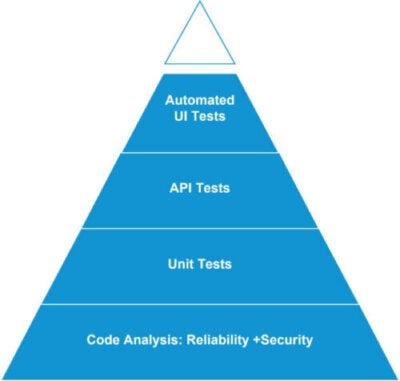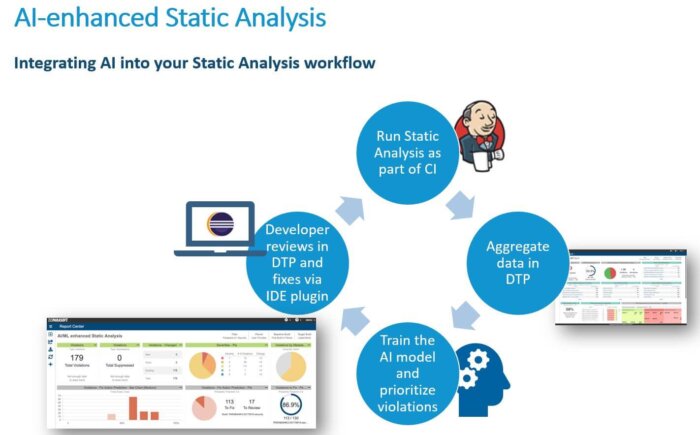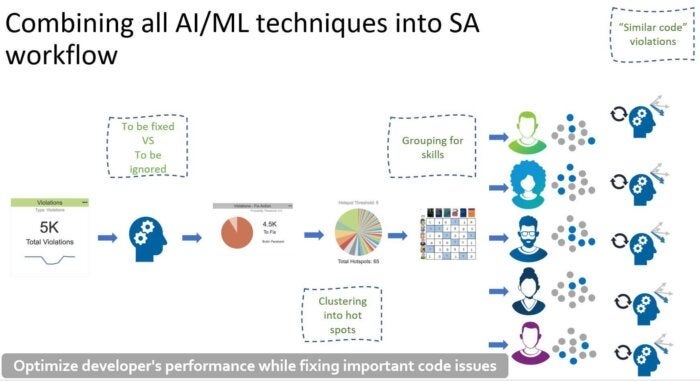Use Agentic AI to generate smarter API tests. In minutes. Learn how >>
Can AI/ML Encourage Devs to Adopt Static Analysis Testing?
Learn about ways that machine learning for artificial intelligence empowers developers to adopt static analysis testing techniques for maximum benefit.

Learn about ways that machine learning for artificial intelligence empowers developers to adopt static analysis testing techniques for maximum benefit.
Testing acceleration goes hand in hand with artificial intelligence and machine learning. This isn’t about androids doing our laundry. It’s about programs that learn over time to enhance processes already in place. For instance, say you order from three different restaurants on a food delivery app in one week after searching for them specifically. The next time you log in to that app, it may now recommend you reorder from those same restaurants because you ordered from them previously.
This process of learning and adapting to the user is exactly how AI and machine learning for static analysis works. It just involves identifying and prioritizing code violations as opposed to ordering your favorite shawarma.
Pro-tip: AI with machine learning for static analysis will make the process simpler and less stressful. So, here’s exactly how to do that by answering the following questions:
Static analysis is used to find vulnerabilities in code, often against industry coding and security standards such as OWASP, CWE, and others. Developers are often not equipped to analyze their own code for these issues or to identify and prioritize what fixes are needed.
It’s true that there is no shortcut or "easy mode" for static analysis testing. You must do it regularly and thoroughly to provide the most utility. However, automating static analysis testing and leveraging machine learning can enhance your results and make things much easier for your developers.
Definitely! Static analysis identifies defects and errors in your source code. In fact, automating static analysis testing via tools further enhances the results you get. While the types of analysis and priorities can differ, the way the SA tool works and applying its methodology are the same.
For example, the various analyses available revolve around four key aspects.
Automating these processes in a continuous manner helps teams manage workflows better by identifying potential issues before they become big problems.
The reasons why many developers view adopting static analysis as both expensive and daunting come down to project scope and approach. Many teams want to tackle what they feel are the most pressing issues first, but also tend to bite off more than they can chew at that time.
Instead, tackle the most significant problems first and limit yourself to one "bite" at a time. However, it should be noted that a "baby step" should not become a stopping point. Safety-critical industries require addressing ALL violations to establish compliance before a product can be released. In the meantime, this step helps prevent your team from being overwhelmed with thousands of violations all at once.
Static analysis is about detecting problems before you even compile and execute the code. But AI can be used to help across multiple levels of software testing such as:

Artificial intelligence helps teams create and maintain automated tests. Moreover, it can optimize test execution and maximize actionable results delivery by augmenting your processes in several ways.
As you automate testing and develop workflows, you can tackle more problems in less time. But triage should be left to your static analysis tools. By working under the supervision of static analysis technologies, developers can expand their skills to learn better coding techniques and write more secure code.
Code analysis offers prevention and detection techniques to control risks associated with the quality of your code. While it helps to identify problems, stopping their occurrences in the first place is a more efficient strategy.
Automating your static analysis enhances the development team’s ability to identify problems regularly and more easily. Adding AI and machine learning to static analysis testing helps teams adopt the practice more easily. It suggests violations be resolved in ways that promote efficiency, optimize workflows, and nurture developer productivity and success.
Besides clustering violations based on advanced classification algorithms, the AI model can leverage different neural networks (code2vec, for example) to vectorize methods of the code and compare them to each other grouping violations according to the semantic meaning of the code surrounding them.
In the same way that developers may address specific violations first, the AI model further empowers them to address violations within similar code. This offers several benefits:
Developers often want to address similar violations at the same time for maximum productivity. That makes sense and artificial intelligence with machine learning should enhance that strategy. This is where something like a "Netflix approach" comes into play.
As you watch shows and movies on the streaming platform, the algorithm learns what kind of shows you do and don’t like. Even without rating anything, it will learn that you prefer action/adventure movies over period dramas based on your watch history. Machine learning for static analysis AI works in a similar way.
Based on previous violations a developer has fixed, the system will suggest similar violations to that developer. It fits their established "profile" based on their history—just like with Netflix’s platform. With this approach, developers will spend less time hunting down similar violations and address violations they are most suited to fixing.

The ways in which AI and machine learning affect static analysis testing fall into the following categories. All of these work in concert to benefit the development process from unifying the source code to identifying security vulnerabilities and cutting down on false positives.

The whole idea behind machine learning is that AI learns as it goes based on observation of users’ actions. It can be trained to identify specific patterns and then adapt in response to those patterns. In accordance with this methodology, identifying clusters and grouping violations work to enhance what developers get out of static analysis testing.
Today’s world of software development moves faster every day thanks to technological development and Agile methodologies. Testing approaches need to keep up and even anticipate advancements. The best way to do that is with solutions that bake in automation and the use of machine learning for AI.
Parasoft solutions leverage AI to flag and prioritize high-priority violations while integrating seamlessly into your CI/CD workflow. Our solutions cover a variety of testing practices supported by C/C++test, Jtest, and dotTEST products.